吸収型NDフィルター、マウント付き

- Optical Densities from 0.1 to 8.0
- Attenuate Visible Light
- Ø1/2", Ø25 mm, and Ø2" Filters Available
- Mounts Engraved with Optical Density
NE10A
Ø25 mm Filter,
SM1-Threaded Mount
NE560A
Ø1/2" Filter,
SM05-Threaded Mount
NE2R01A
Ø2" Filter,
SM2-Threaded Mount
NE04A, SM1A9 Adapter,
and Shack-Hartmann
Wavefront Sensor

Please Wait
| Neutral Density Filter Selection Guide | |
|---|---|
| Absorptive | |
| Uncoated (400 - 650 nm) | Mounted |
| Unmounted | |
| Uncoated (1000 - 2600 nm) | Mounted |
| Unmounted | |
| AR Coated (350 - 700 nm) | Mounted |
| Unmounted | |
| AR Coated (650 - 1050 nm) | Mounted |
| Unmounted | |
| AR Coated (1050 - 1700 nm) | Mounted |
| Unmounted | |
| Variable | |
| Reflective | |
| UV Fused Silica (200 - 1200 nm) | Mounted |
| Unmounted | |
| N-BK7 (350 - 1100 nm) | Mounted |
| Unmounted | |
| ZnSe (2 - 16 µm) | Mounted |
| Unmounted | |
| Wedged UVFS (200 - 1200 nm) | |
| Wedged N-BK7 (350 - 1100 nm) | |
| Wedged ZnSe (2 - 16 µm) | |
| Variable | |
| Neutral Density Filter Kits | |
特長
- 3つのサイズ:
- Ø12.7 mm(Ø1/2インチ)フィルタ、SM05マウント付き
- Ø25 mmフィルタ、SM1マウント付き
- Ø50.8 mm(Ø2インチ)フィルタ、SM2マウント付き
- 光学濃度: 0.1~8.0
- 低出力の用途に (< 1 W、詳細は「仕様」タブ参照)
- マウントには型番と光学濃度を刻印
- 吸収型ガラスが多重反射を抑制
当社のマウント付き吸収型NDフィルタは、0.1~8.0の範囲の光学濃度をご用意しています。 直径は12.7 mm(1/2インチ)、25 mm、および50.8 mm(2インチ)の3種類があり、それぞれSM05、SM1、SM2レンズチューブに取り付けられています。 この筐体には、見分けやすいように型番と光学濃度が刻印されており、当社のケージシステムやレンズチューブなど、さまざまな丈夫なオプトメカニクス部品に直接取り付けることができます。フィルタは単体またはフィルターキットで別途ご購入いただけます。当社ではマウント付きフィルタを収納可能な緩衝材入りケースもご用意しております(下記参照)。
反射型(金属)NDフィルタとは異なり、各吸収型NDフィルタは400~650 nmの可視域で均一な吸収係数を示すSchott社製ガラス基板から製造されています。使用するガラスのタイプや厚さを変えることによって、4種類のSchott 社製ガラスから全ての吸収型NDフィルタを製造しています。ガラスのロット毎にバラツキが生じるため、当社では定量的な測定をされる前に、光学系内でフィルタの校正を行っていただくことをお勧めしています。「仕様」タブには、フィルタの種類別の透過率と損傷閾値の公称値が掲載されています。また「グラフ」タブには300~1100 nmの波長範囲での透過率曲線と反射率曲線を掲載しています。
ご希望があれば、マウント付きフィルタはフィルタをマウントに固定している固定リングを外し、筐体から取り外すことが可能です。当社ではこの固定リングにお使いいただけるスパナレンチも多数ご用意しています。このページでご紹介している円形フィルタはマウント無しでもご用意しています。対応するマウント無しフィルタについては、下記型番横の赤いアイコン (![]() ) をクリックしてご覧いただける図に記載しています。
) をクリックしてご覧いただける図に記載しています。
こちらのページのフィルタはコーティング無しの製品です。コーティング付きおよびコーティング無しの全NDフィルタのラインナップは右表をご覧ください。
光学濃度と透過率
光学濃度(OD)は光学フィルタによりもたらされる減衰率、つまり入射ビームの光パワーをどれだけ減少させるかを示しています。光学濃度(OD)は透過率Tの関数として次の方程式で表されます。

Tは0から1の間の値です。光学濃度の高いNDフィルタ(吸収型)を選択した場合、入射光の吸収率は高く、透過率は低くなります。透過率を高く、吸収率を低くするためには、低い光学濃度のNDフィルタが適切と言えます。例えば、光学濃度2のフィルタでは透過率が0.01であり、フィルタは入射ビームのパワーを1%まで減衰させるという結果になります。当社のNDフィルタの透過率のデータは、パーセント(%)で表示されています。
これらの製品は、レーザ安全装置用にはつくられておりませんので、ご注意ください。当社では、安全に実験を行っていただくために、迷光の照射を著しく低減できるビームブロックなど、安全保護具や遮光用製品をご用意しております。
| Filter Sizes | Ø1/2" | Ø25 mm | Ø2" |
|---|---|---|---|
| Diameter Tolerance | +0.0 / -0.25 mm | ||
| Clear Aperture | > Ø11.0 mm | > Ø20.0 mm | > Ø45.7 mm |
| Surface Quality | 40-20 Scratch-Dig | ||
| Substrate | NG1, NG4, NG9, or NG11 (Schott Glass) | ||
| For OD < 1.3: | |||
| Transmitted Wavefront Error (TWE) | < λ/4 (@ 633 nm) | < λ/4 (@ 633 nm) | < λ/4 (@ 633 nm) |
| For OD ≥ 1.3: | |||
| Surface Flatness | < λ/2 (@ 633 nm) | - | < 2λ (@ 633 nm) |
| Transmitted Wavefront Error (TWE) | - | < λ/4 (@ 633 nm) | - |
| Damage Threshold Specifications | ||
|---|---|---|
| Optical Density | Damage Threshold | |
| 0.2 | Pulsed | 10 J/cm2 (532 nm, 10 ns, 10 Hz, Ø0.456 mm) |
| 0.3 | CWa | 25 W/cm (532 nm, Ø1.0 mm) |
| 1.0 | CWa | 12 W/cm (532 nm, Ø1.0 mm) |
| Pulsed | 10 J/cm2 (532 nm, 10 ns, 10 Hz, Ø0.504 mm) | |
| 2.0 | CWa,b | 12 W/cm (532 nm, Ø1.0 mm) |
| Pulsed | 10 J/cm2 (532 nm, 10 ns, 10 Hz, Ø0.390 mm) | |
| 4.0 | CWa | 10 W/cm (532 nm, Ø1.0 mm) |
| Pulsed | 5 J/cm2 (532 nm, 10 ns, 10 Hz, Ø0.340 mm) | |
| 6.0 | Pulsed | 5 J/cm2 (532 nm, 10 ns, 10 Hz, Ø0.340 mm) |
| Optical Density (@ 633 nm) | Theoretical Transmissiona (@ 633 nm) | Substrate Thicknessb | Substrate |
|---|---|---|---|
| 0.1 ± 0.01 | 77.6 to 81.3% | 0.6 mm | NG11 |
| 0.2 ± 0.01 | 61.7 to 64.6% | 1.4 mm | NG11 |
| 0.3 ± 0.015 | 50% | 2.3 mm | NG11 |
| 0.4 ± 0.02 | 40% | 0.7 mm | NG4 |
| 0.5 ± 0.025 | 32% | 0.9 mm | NG4 |
| 0.6 ± 0.03 | 25% | 1.1 mm | NG4 |
| 0.7 ± 0.035 | 20% | 1.3 mm | NG4 |
| 0.8 ± 0.04 | 16% | 1.5 mm | NG4 |
| 0.9 ± 0.045 | 13% | 1.7 mm | NG4 |
| 1.0 ± 0.05 | 10% | 1.9 mm | NG4 |
| 1.3 ± 0.065 | 5% | 2.5 mm | NG4 |
| 1.5 ± 0.075 | 3% | 2.9 mm | NG4 |
| 2.0 ± 0.10 | 1% | 1.4 mm | NG9 |
| 3.0 ± 0.15 | 0.1% | 2.1 mm | NG9 |
| 4.0 ± 0.20 | 1.0x10-2% | 2.8 mm | NG9 |
| 5.0 ± 0.25 | 1.0x10-3% | 3.6 mm | NG9 |
| 6.0 ± 0.30 | 1.0x10-4% | 1.5 mm | NG1 |
| 7.0 ± 0.35 | 1.0x10-5% | 1.7 mm | NG1 |
| 8.0 ± 0.40 | 1.0x10-6% | 1.9 mm | NG1 |
光学濃度
光学濃度(OD)は光学フィルタによりもたらされる減衰率、つまり入射ビームの光パワーをどれだけ減少させるかを示しています。光学濃度(OD)は透過率Tの関数として次の方程式で表されます。

Tは0から1の間の値です。光学濃度の高いNDフィルタ(吸収型)を選択した場合、入射光の吸収率は高く、透過率は低くなります。透過率を高く、吸収率を低くするためには、低い光学濃度のNDフィルタが適切と言えます。例えば、光学濃度2のフィルタでは透過率が0.01であり、フィルタは入射ビームのパワーを1%まで減衰させるという結果になります。当社のNDフィルタの透過率のデータは、パーセント(%)で表示されています。
| 詳細な情報について | |
|---|---|
各フィルタの波長毎の透過率(および光学濃度)のプロット図は、表の左のアイコンをクリックしてご覧下さい。このプロット図の生データが掲載されたエクセルファイルもダウンロード可能です。 | |
| Optical Density | Transmission 型番毎の生データは下の表の青いInfoアイコンをクリックするとダウンロードいただけます。 | Reflectance AOI 8°での反射率データのエクセルもダウンロード可能です。 |
|---|---|---|
| OD 0.1 - 0.5 | ||
| OD 0.6 - 0.9 | ||
| OD 1.0 - 2.0 | ||
| OD 3.0 - 4.0 | ||
| OD 5.0 - 6.0 | ||
| OD 7.0 - 8.0 |
| Damage Threshold Specifications | ||
|---|---|---|
| Optical Density | Damage Threshold | |
| 0.2 | Pulsed | 10 J/cm2 (532 nm, 10 ns, 10 Hz, Ø0.456 mm) |
| 0.3 | CWa | 25 W/cm (532 nm, Ø1.0 mm) |
| 1.0 | CWa | 12 W/cm (532 nm, Ø1.0 mm) |
| Pulsed | 10 J/cm2 (532 nm, 10 ns, 10 Hz, Ø0.504 mm) | |
| 2.0 | CWa,b | 12 W/cm (532 nm, Ø1.0 mm) |
| Pulsed | 10 J/cm2 (532 nm, 10 ns, 10 Hz, Ø0.390 mm) | |
| 4.0 | CWa | 10 W/cm (532 nm, Ø1.0 mm) |
| Pulsed | 5 J/cm2 (532 nm, 10 ns, 10 Hz, Ø0.340 mm) | |
| 6.0 | Pulsed | 5 J/cm2 (532 nm, 10 ns, 10 Hz, Ø0.340 mm) |
当社の吸収型NDフィルタの損傷閾値データ
右の仕様は当社の吸収型NDフィルタの測定データです。損傷閾値の仕様は光学濃度が同じであればフィルタのサイズにかかわらず同じです。
レーザによる損傷閾値について
このチュートリアルでは、レーザ損傷閾値がどのように測定され、使用する用途に適切な光学素子の決定にその値をどのようにご利用いただけるかを総括しています。お客様のアプリケーションにおいて、光学素子を選択する際、光学素子のレーザによる損傷閾値(Laser Induced Damage Threshold :LIDT)を知ることが重要です。光学素子のLIDTはお客様が使用するレーザの種類に大きく依存します。連続(CW)レーザは、通常、吸収(コーティングまたは基板における)によって発生する熱によって損傷を引き起こします。一方、パルスレーザは熱的損傷が起こる前に、光学素子の格子構造から電子が引き剥がされることによって損傷を受けます。ここで示すガイドラインは、室温で新品の光学素子を前提としています(つまり、スクラッチ&ディグ仕様内、表面の汚染がないなど)。光学素子の表面に塵などの粒子が付くと、低い閾値で損傷を受ける可能性があります。そのため、光学素子の表面をきれいで埃のない状態に保つことをお勧めします。光学素子のクリーニングについては「光学素子クリーニングチュートリアル」をご参照ください。
テスト方法
当社のLIDTテストは、ISO/DIS 11254およびISO 21254に準拠しています。
初めに、低パワー/エネルギのビームを光学素子に入射します。その光学素子の10ヶ所に1回ずつ、設定した時間(CW)またはパルス数(決められたprf)、レーザを照射します。レーザを照射した後、倍率約100倍の顕微鏡を用いた検査で確認し、すべての確認できる損傷を調べます。特定のパワー/エネルギで損傷のあった場所の数を記録します。次に、そのパワー/エネルギを増やすか減らすかして、光学素子にさらに10ヶ所レーザを照射します。このプロセスを損傷が観測されるまで繰返します。損傷閾値は、光学素子が損傷に耐える、損傷が起こらない最大のパワー/エネルギになります。1つのミラーBB1-E02の試験結果は以下のようなヒストグラムになります。
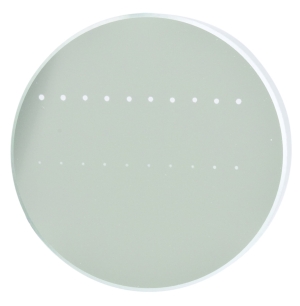
上の写真はアルミニウムをコーティングしたミラーでLIDTテストを終えたものです。このテストは、損傷を受ける前のレーザのエネルギは0.43 J/cm2 (1064 nm、10 ns pulse、 10 Hz、Ø1.000 mm)でした。
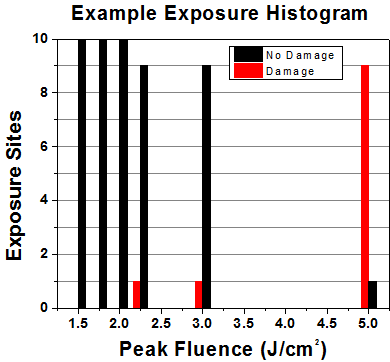
| Example Test Data | |||
|---|---|---|---|
| Fluence | # of Tested Locations | Locations with Damage | Locations Without Damage |
| 1.50 J/cm2 | 10 | 0 | 10 |
| 1.75 J/cm2 | 10 | 0 | 10 |
| 2.00 J/cm2 | 10 | 0 | 10 |
| 2.25 J/cm2 | 10 | 1 | 9 |
| 3.00 J/cm2 | 10 | 1 | 9 |
| 5.00 J/cm2 | 10 | 9 | 1 |
試験結果によれば、ミラーの損傷閾値は 2.00 J/cm2 (532 nm、10 ns pulse、10 Hz、 Ø0.803 mm)でした。尚、汚れや汚染によって光学素子の損傷閾値は大幅に低減されるため、こちらの試験はクリーンな光学素子で行っています。また、特定のロットのコーティングに対してのみ試験を行った結果ではありますが、当社の損傷閾値の仕様は様々な因子を考慮して、実測した値よりも低めに設定されており、全てのコーティングロットに対して適用されています。
CWレーザと長パルスレーザ
光学素子がCWレーザによって損傷を受けるのは、通常バルク材料がレーザのエネルギを吸収することによって引き起こされる溶解、あるいはAR(反射防止)コーティングのダメージによるものです[1]。1 µsを超える長いパルスレーザについてLIDTを論じる時は、CWレーザと同様に扱うことができます。
パルス長が1 nsと1 µs の間のときは、損傷は吸収、もしくは絶縁破壊のどちらかで発生していると考えることができます(CWとパルスのLIDT両方を調べなければなりません)。吸収は光学素子の固有特性によるものか、表面の不均一性によるものかのどちらかによって起こります。従って、LIDTは製造元の仕様以上の表面の質を有する光学素子にのみ有効です。多くの光学素子は、ハイパワーCWレーザで扱うことができる一方、アクロマティック複レンズのような接合レンズやNDフィルタのような高吸収光学素子は低いCWレーザ損傷閾値になる傾向にあります。このような低い損傷閾値は接着剤や金属コーティングにおける吸収や散乱によるものです。
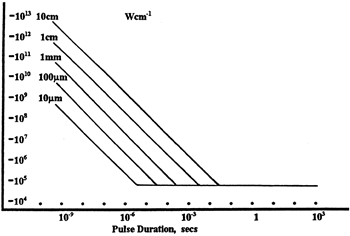
線形パワー密度におけるLIDTに対するパルス長とスポットサイズ。長パルス~CWでは線形パワー密度はスポットサイズにかかわらず一定です。 このグラフの出典は[1]です。
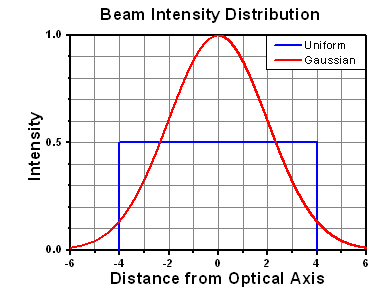
繰返し周波数(prf)の高いパルスレーザは、光学素子に熱的損傷も引き起こします。この場合は吸収や熱拡散率のような因子が深く関係しており、残念ながらprfの高いレーザが熱的影響によって光学素子に損傷を引き起こす場合の信頼性のあるLIDTを求める方法は確立されておりません。prfの大きいビームでは、平均出力およびピークパワーの両方を等しいCW出力と比較する必要があります。また、非常に透過率の高い材料では、prfが上昇してもLIDTの減少は皆無かそれに近くなります。
ある光学素子の固有のCWレーザの損傷閾値を使う場合には、以下のことを知る必要があります。
- レーザの波長
- ビーム径(1/e2)
- ビームのおおよその強度プロファイル(ガウシアン型など)
- レーザのパワー密度(トータルパワーをビームの強度が1/e2の範囲の面積で割ったもの)
ビームのパワー密度はW/cmの単位で計算します。この条件下では、出力密度はスポットサイズとは無関係になります。つまり、スポットサイズの変化に合わせてLIDTを計算し直す必要がありません(右グラフ参照)。平均線形パワー密度は、下の計算式で算出できます。

ここでは、ビーム強度プロファイルは一定であると仮定しています。次に、ビームがホットスポット、または他の不均一な強度プロファイルの場合を考慮して、おおよその最大パワー密度を計算する必要があります。ご参考までに、ガウシアンビームのときはビームの強度が1/e2の2倍のパワー密度を有します(右下図参照)。
次に、光学素子のLIDTの仕様の最大パワー密度を比較しましょう。損傷閾値の測定波長が光学素子に使用する波長と異なっている場合には、その損傷閾値は適宜補正が必要です。おおよその目安として参考にできるのは、損傷閾値は波長に対して比例関係であるということです。短い波長で使う場合、損傷閾値は低下します(つまり、1310 nmで10 W/cmのLIDTならば、655 nmでは5 W/cmと見積もります)。

この目安は一般的な傾向ですが、LIDTと波長の関係を定量的に示すものではありません。例えば、CW用途では、損傷はコーティングや基板の吸収によってより大きく変化し、必ずしも一般的な傾向通りとはなりません。上記の傾向はLIDT値の目安として参考にしていただけますが、LIDTの仕様波長と異なる場合には当社までお問い合わせください。パワー密度が光学素子の補正済みLIDTよりも小さい場合、この光学素子は目的の用途にご使用いただけます。
当社のウェブ上の損傷閾値の仕様と我々が行った実際の実験の値の間にはある程度の差があります。これはロット間の違いによって発生する誤差を許容するためです。ご要求に応じて、当社は個別の情報やテスト結果の証明書を発行することもできます。損傷解析は、類似した光学素子を用いて行います(お客様の光学素子には損傷は与えません)。試験の費用や所要時間などの詳細は、当社までお問い合わせください。
パルスレーザ
先に述べたように、通常、パルスレーザはCWレーザとは異なるタイプの損傷を光学素子に引き起こします。パルスレーザは損傷を与えるほど光学素子を加熱しませんが、光学素子から電子をひきはがします。残念ながら、お客様のレーザに対して光学素子のLIDTの仕様を照らし合わせることは非常に困難です。パルスレーザのパルス幅に起因する光学素子の損傷には、複数の形態があります。以下の表中のハイライトされた列は当社の仕様のLIDT値が当てはまるパルス幅に対する概要です。
パルス幅が10-9 sより短いパルスについては、当社の仕様のLIDT値と比較することは困難です。この超短パルスでは、多光子アバランシェ電離などのさまざまなメカニクスが損傷機構の主流になります[2]。対照的に、パルス幅が10-7 sと10-4 sの間のパルスは絶縁破壊、または熱的影響により光学素子の損傷を引き起こすと考えられます。これは、光学素子がお客様の用途に適しているかどうかを決定するために、レーザービームに対してCWとパルス両方による損傷閾値を参照しなくてはならないということです。
| Pulse Duration | t < 10-9 s | 10-9 < t < 10-7 s | 10-7 < t < 10-4 s | t > 10-4 s |
|---|---|---|---|---|
| Damage Mechanism | Avalanche Ionization | Dielectric Breakdown | Dielectric Breakdown or Thermal | Thermal |
| Relevant Damage Specification | No Comparison (See Above) | Pulsed | Pulsed and CW | CW |
お客様のパルスレーザに対してLIDTを比較する際は、以下のことを確認いただくことが重要です。
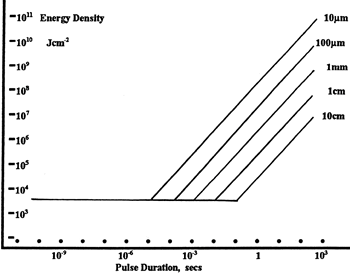
エネルギ密度におけるLIDTに対するパルス長&スポットサイズ。短パルスでは、エネルギ密度はスポットサイズにかかわらず一定です。このグラフの出典は[1]です。
- レーザの波長
- ビームのエネルギ密度(トータルエネルギをビームの強度が1/e2の範囲の面積で割ったもの)
- レーザのパルス幅
- パルスの繰返周波数(prf)
- 実際に使用するビーム径(1/e2 )
- ビームのおおよその強度プロファイル(ガウシアン型など)
ビームのエネルギ密度はJ/cm2の単位で計算します。右のグラフは、短パルス光源には、エネルギ密度が適した測定量であることを示しています。この条件下では、エネルギ密度はスポットサイズとは無関係になります。つまり、スポットサイズの変化に合わせてLIDTを計算し直す必要がありません。ここでは、ビーム強度プロファイルは一定であると仮定しています。ここで、ビームがホットスポット、または他の不均一な強度プロファイルの場合を考慮して、おおよその最大パワー密度を計算する必要があります。ご参考までに、ガウシアンビームのときは一般にビームの強度が1/e2のときの2倍のパワー密度を有します。
次に、光学素子のLIDTの仕様と最大エネルギ密度を比較しましょう。損傷閾値の測定波長が光学素子に使用する波長と異なっている場合には、その損傷閾値は適宜補正が必要です[3]。経験則から、損傷閾値は波長に対して以下のような平方根の関係であるということです。短い波長で使う場合、損傷閾値は低下します(例えば、1064 nmで 1 J/cm2のLIDTならば、532 nmでは0.7 J/cm2と計算されます)。

波長を補正したエネルギ密度を得ました。これを以下のステップで使用します。
ビーム径は損傷閾値を比較する時にも重要です。LIDTがJ/cm2の単位で表される場合、スポットサイズとは無関係になりますが、ビームサイズが大きい場合、LIDTの不一致を引き起こす原因でもある不具合が、より明らかになる傾向があります[4]。ここで示されているデータでは、LIDTの測定には<1 mmのビーム径が用いられています。ビーム径が5 mmよりも大きい場合、前述のようにビームのサイズが大きいほど不具合の影響が大きくなるため、LIDT (J/cm2)はビーム径とは無関係にはなりません。
次に、パルス幅について補正します。パルス幅が長くなるほど、より大きなエネルギに光学素子は耐えることができます。パルス幅が1~100 nsの場合の近似式は以下のようになります。

お客様のレーザのパルス幅をもとに、光学素子の補正されたLIDTを計算するのにこの計算式を使います。お客様の最大エネルギ密度が、この補正したエネルギ密度よりも小さい場合、その光学素子はお客様の用途でご使用いただけます。ご注意いただきたい点は、10-9 s と10-7 sの間のパルスにのみこの計算が使えることです。パルス幅が10-7 sと10-4 sの間の場合には、CWのLIDTも調べなければなりません。
当社のウェブ上の損傷閾値の仕様と我々が行った実際の実験の値の間にはある程度の差があります。これはロット間の違いによって発生する誤差を許容するためです。ご要求に応じて、当社では個別のテスト情報やテスト結果の証明書を発行することも可能です。詳細は、当社までお問い合わせください。
[1] R. M. Wood, Optics and Laser Tech. 29, 517 (1997).
[2] Roger M. Wood, Laser-Induced Damage of Optical Materials (Institute of Physics Publishing, Philadelphia, PA, 2003).
[3] C. W. Carr et al., Phys. Rev. Lett. 91, 127402 (2003).
[4] N. Bloembergen, Appl. Opt. 12, 661 (1973).
レーザーシステムが光学素子に損傷を引き起こすかどうか判断するプロセスを説明するために、レーザによって引き起こされる損傷閾値(LIDT)の計算例をいくつかご紹介します。同様の計算を実行したい場合には、右のボタンをクリックしてください。計算ができるスプレッドシートをダウンロードいただけます。ご使用の際には光学素子のLIDTの値と、レーザーシステムの関連パラメータを緑の枠内に入力してください。スプレッドシートでCWならびにパルスの線形パワー密度、ならびにパルスのエネルギ密度を計算できます。これらの値はスケーリング則に基づいて、光学素子のLIDTの調整スケール値を計算するのに用いられます。計算式はガウシアンビームのプロファイルを想定しているため、ほかのビーム形状(均一ビームなど)には補正係数を導入する必要があります。 LIDTのスケーリング則は経験則に基づいていますので、確度は保証されません。なお、光学素子やコーティングに吸収があると、スペクトル領域によってLIDTが著しく低くなる場合があります。LIDTはパルス幅が1ナノ秒(ns)未満の超短パルスには有効ではありません。

ガウシアンビームの最大強度は均一ビームの約2倍です。
CWレーザの例
波長1319 nm、ビーム径(1/e2)10 mm、パワー0.5 Wのガウシアンビームを生成するCWレーザーシステム想定します。このビームの平均線形パワー密度は、全パワーをビーム径で単純に割ると0.5 W/cmとなります。

しかし、ガウシアンビームの最大パワー密度は均一ビームの約2倍です(右のグラフ参照)。従って、システムのより正確な最大線形パワー密度は1 W/cmとなります。
アクロマティック複レンズAC127-030-CのCW LIDTは、1550 nmでテストされて350 W/cmとされています。CWの損傷閾値は通常レーザ光源の波長に直接スケーリングするため、LIDTの調整値は以下のように求められます。

LIDTの調整値は350 W/cm x (1319 nm / 1550 nm) = 298 W/cmと得られ、計算したレーザーシステムのパワー密度よりも大幅に高いため、この複レンズをこの用途に使用しても安全です。
ナノ秒パルスレーザの例:パルス幅が異なる場合のスケーリング
出力が繰返し周波数10 Hz、波長355 nm、エネルギ1 J、パルス幅2 ns、ビーム径(1/e2)1.9 cmのガウシアンビームであるNd:YAGパルスレーザーシステムを想定します。各パルスの平均エネルギ密度は、パルスエネルギをビームの断面積で割って求めます。

上で説明したように、ガウシアンビームの最大エネルギ密度は平均エネルギ密度の約2倍です。よって、このビームの最大エネルギ密度は約0.7 J/cm2です。
このビームのエネルギ密度を、広帯域誘電体ミラーBB1-E01のLIDT 1 J/cm2、そしてNd:YAGレーザーラインミラーNB1-K08のLIDT 3.5 J/cm2と比較します。LIDTの値は両方とも、波長355 nm、パルス幅10 ns、繰返し周波数10 Hzのレーザで計測しました。従って、より短いパルス幅に対する調整を行う必要があります。 1つ前のタブで説明したようにナノ秒パルスシステムのLIDTは、パルス幅の平方根にスケーリングします:

この調整係数により広帯域誘電体ミラーBB1-E01のLIDTは0.45 J/cm2に、Nd:YAGレーザーラインミラーのLIDTは1.6 J/cm2になり、これらをビームの最大エネルギ密度0.7 J/cm2と比較します。広帯域ミラーはレーザによって損傷を受ける可能性があり、より特化されたレーザーラインミラーがこのシステムには適していることが分かります。
ナノ秒パルスレーザの例:波長が異なる場合のスケーリング
波長1064 nm、繰返し周波数2.5 Hz、パルスエネルギ100 mJ、パルス幅10 ns、ビーム径(1/e2)16 mmのレーザ光を、NDフィルタで減衰させるようなパルスレーザーシステムを想定します。これらの数値からガウシアン出力における最大エネルギ密度は0.1 J/cm2になります。Ø25 mm、OD 1.0の反射型NDフィルタ NDUV10Aの損傷閾値は355 nm、10 nsのパルスにおいて0.05 J/cm2で、同様の吸収型フィルタ NE10Aの損傷閾値は532 nm、10 nsのパルスにおいて10 J/cm2です。1つ前のタブで説明したように光学素子のLIDTは、ナノ秒パルス領域では波長の平方根にスケーリングします。

スケーリングによりLIDTの調整値は反射型フィルタでは0.08 J/cm2、吸収型フィルタでは14 J/cm2となります。このケースでは吸収型フィルタが光学損傷を防ぐには適した選択肢となります。
マイクロ秒パルスレーザの例
パルス幅1 µs、パルスエネルギ150 µJ、繰返し周波数50 kHzで、結果的にデューティーサイクルが5%になるレーザーシステムについて考えてみます。このシステムはCWとパルスレーザの間の領域にあり、どちらのメカニズムでも光学素子に損傷を招く可能性があります。レーザーシステムの安全な動作のためにはCWとパルス両方のLIDTをレーザーシステムの特性と比較する必要があります。
この比較的長いパルス幅のレーザが、波長980 nm、ビーム径(1/e2)12.7 mmのガウシアンビームであった場合、線形パワー密度は5.9 W/cm、1パルスのエネルギ密度は1.2 x 10-4 J/cm2となります。これをポリマーゼロオーダ1/4波長板WPQ10E-980のLIDTと比較してみます。CW放射に対するLIDTは810 nmで5 W/cm、10 nsパルスのLIDTは810 nmで5 J/cm2です。前述同様、光学素子のCW LIDTはレーザ波長と線形にスケーリングするので、CWの調整値は980 nmで6 W/cmとなります。一方でパルスのLIDTはレーザ波長の平方根とパルス幅の平方根にスケーリングしますので、1 µsパルスの980 nmでの調整値は55 J/cm2です。光学素子のパルスのLIDTはパルスレーザのエネルギ密度よりはるかに大きいので、個々のパルスが波長板を損傷することはありません。しかしレーザの平均線形パワー密度が大きいため、高出力CWビームのように光学素子に熱的損傷を引き起こす可能性があります。
| Posted Comments: | |
dmallic1
(posted 2017-01-18 18:45:45.55) I found an NE10A filter in my lab, used our 3J over 1.2cm diameter 1064nm 10ns 10Hz ND YAG pulse laser. It took 4 pulses and broke in half. Any ideas on how to prevent that? Or a product that wont fail under such extreme conditions? tfrisch
(posted 2017-01-25 05:36:59.0) Hello, thank you for contacting Thorlabs. I will reach out to you directly about your application. kyle.j.wilkin
(posted 2016-06-29 23:30:57.343) Hello,
Do you have any data or customer feedback on ultra-short pulses? The page says they cannot be reliably trusted but by how much? With the LIDT calculations I 24 mJ/cm^2 and 48 mJ/cm^2 for the high and low OD respectively. My laser is about 16 mJ/cm^2. I assume the high OD is too close to trust but the low is a factor of 4 higher. Is that a large enough difference to trust? It is a 1 kHz 800 nm laser with a 15 fs pulse length. It is a fairly large beam at 0.8 cm^2. sevenof9
(posted 2016-06-08 08:03:01.35) no C-mount filters ???
only adapter-rings ???
i buy it from edmund :P besembeson
(posted 2016-06-08 10:19:11.0) Response from Bweh at Thorlabs USA: Thanks for your feedback. You are correct at the moment we do have the adapters to go from our standard threads to C-mount or any other, which makes it more flexible. We will be reviewing your suggestion. user
(posted 2016-01-08 13:16:35.137) The ND filter damage thresholds are spec'd in units of energy per unit area (joules/cm^2), but in the tutorial you recommend using the LIDT metric in linear watts/cm. How do we relate the two please? From the included plot, for CW, the linear LIDT graph shows roughly 10^5 watts/cm. I appreciate the tutorial, but to me it's not clear how to apply to and verify a given application (e.g. CW at 635nm, 5mw source). Thanks. besembeson
(posted 2016-01-12 04:59:44.0) Response from Bweh at Thorlabs USA: Damage threshold units of Energy per unit area is specified for pulsed sources whereas our recommended linear W/cm is specified for cw sources. We have separated the footnotes we had on the webpages to make this clearer. Please contact me at techsupport@thorlabs.com if you need further verification for your application. jlow
(posted 2015-11-16 01:46:44.0) Response from Jeremy at Thorlabs: The ND filters can be cleaned like regular optics with solvents such as isopropyl alcohol. djs1
(posted 2015-05-08 12:38:26.857) Hello,
I am interested in buying a range of filters for use at 792nm (~50% transmission, ~10% trans and ~1% trans). By looking at your published graphs, it looks like NE03A, NE13A and NE30A are approximately right for me (although I might choose the square versions instead). How reliable are the transmission graphs, please? A variation of ~10% would be no problem, but it would be a bit pointless if two of the filters turned out to have the same optical density.
All the best,
David. jlow
(posted 2015-05-13 10:35:03.0) Response from Jeremy at Thorlabs: The tolerance of the optical density is listed under the "Specs" tab. There should only be slight variation of the transmission of each filter as compared to the ones on the website. I will contact you directly to discuss more about this. schwettmann
(posted 2015-02-19 21:50:59.123) I hit the NE30A, and also NE20A, with a 1.4 Watt 589nm cw beam, 1/e^2 beam diameter diameter of ~3mm, way below quoted damage threshold.
I saw definitive focussing behaviour, increasing for about 1.5 seconds after initial turning on of the beam, then constant focussing. In addition, the spatial pattern of polarization of my beam was affected in very interesting patterns.
I think this filter is great for low powers, but due to this effect it has on beam collimation and polarization at high powers ~1W CW, it is only marginally useful in this case. besembeson
(posted 2015-02-27 04:48:50.0) Response from Bweh at Thorlabs USA: You are observing a thermal lensing effect due to the higher absorption for the 2 and 3 OD filters, which is not an indication of damage, but of heating. You may want to consider the reflective counterparts if that will also be suitable in your setup. mary.frawley
(posted 2010-06-14 11:56:38.0) Hi,
Can you please send me the transmission curve for the NE filters (NE01A to NE40A) for 1064nm?
Thanks,
Mary Javier
(posted 2010-06-09 10:50:26.0) Response from Javier at Thorlabs to jc7 and mario.montes.usategui: the transmission characteristics of absorptive neutral density filters are highly dependent on wavelength. Above 1000 nm, the transmission of these filters usually increases steadily, resulting in different optical density values. I will contact you directly with transmission curves. jc7
(posted 2010-06-08 23:21:52.0) Hello, Could you please also provide me the transmission curves for your ND filters in the NIR range? Thanks! mario.montes.usategui
(posted 2010-06-08 23:52:42.0) Hi,
I seem to have the same problem as others before. I bought filters NE01A, NE05A, NE10A, and NE20A and found that the transmission for 1064 nm is different from what I expected (I did not check the curves you display, my fault). For example the transmission of the D=2 filter is higher than the combination of the filters with densities 1, 0.5, 0.1 (x2), which should add up to D=1.7.
Could you, please, send me the curves (or specifically, transmission for lambda=1064 nm) for all these filters?
That will help me a lot.
Thanks in advance! user
(posted 2010-06-07 14:22:54.0) Response from Javier at Thorlabs to adam.wade: we are currently looking into the design of absorptive neutral density filters for the NIR wavelength range. However, we do not offer them, yet. In the meantime, I can provide you with typical transmission curves for the ND filters that we currently offer; you might find suitable for your application. I will contact you directly. adam.wade
(posted 2010-06-04 17:40:41.0) I am looking to purchase a set of absorptive ND filters ranging from OD 1-4 for working in the 1550nm range. Having them mounted in a 1’ holder would be nice. It looks like the performance of the higher OD filters starts degrading rapidly outside of the visible range. Is this something that could be special ordered?
Adam Wade
Optical Engineer
Geost
(520) 575-8001 Adam
(posted 2010-04-28 16:09:40.0) A response from Adam at Thorlabs, Inc. The tranmission of the ND filters is not dependent upon the source. If the wavelength of the light is the same for both the CW light and the pulsed light, you should see the same transmission through the ND filter. Adam
(posted 2010-04-14 14:55:41.0) A response from Adam at Thorlabs to gsakson: We can provide custom absorptive NE filters that will transmit 5% and 8%. I will contact you directly to get more information. gsakson
(posted 2010-04-14 09:55:51.0) Hello
I’m looking for Neutral Density Filters on transmission 5% and 8%.
Unfortunately is not possible to purchase their on the local market.
Could I ask you for a contact window to a person that deals with this case?
I would be really grateful.
Best regards,
Grzegorz Sakson
Best regards, Greg
(posted 2010-04-07 08:18:46.0) A response from Greg at Thorlabs to fschewe: Thank you for bringing this to our attention. I have updated the link to go to our current AR-Coated Absorptive ND Filters. fschewe
(posted 2010-04-07 06:05:06.0) By clicking on the first "Related Product" (Absorptive ND Filter AR-Coated) Im forwarded to an obsolete product. apalmentieri
(posted 2009-10-23 10:43:42.0) A response from Adam at Thorlabs: The NE filters are tested and measured at 633nm. The values at 350nm will be slightly different and I will send you this information via email. I would also like to get more information about your setup and the rings you are seeing. I will inquire about this via email as well. fjin
(posted 2009-10-22 16:26:04.0) First, what are the transmission for this series of ND filter at UV, say 350nm, spectral range?
Second, when I insert this filter after a diode pumped solid state laser working at its third harmonic wavelength, I saw a couple of concentric rings after the filter. The rings were not there if I remove the filter. Do you know why?
Thanks,
Feng klee
(posted 2009-10-16 10:36:25.0) A response from Ken at Thorlabs to stripa3: No, these ND filters do not show any focusing behavior. stripa3
(posted 2009-10-16 02:24:46.0) does these nd filters show focusing behavior? Greg
(posted 2009-03-11 16:25:09.0) A response from Greg at Thorlabs to beattieb: I sent you the transmission curves for our OD4 and OD5 absorptive ND filters via e-mail. I am currently reworking this webpage and will also work on the transmission curves. I will be sure to make them easier to read. beattieb
(posted 2009-03-11 14:33:48.0) I cant make out the transmission (vs wavelength) curves for D=4 and D=5 filters. Could you please send me this data on a log scale and/or the actual numbers.
Thanks,
Brad Beattie
Memorial Sloan Kettering Cancer Center Laurie
(posted 2009-02-09 08:15:37.0) Response from Laurie at Thorlabs to mpartlow: Thank you for your interest ino ur NExx filters. These filters are designed for visible wavelengths, and hence, the NE03 offers higher transmission than NE04 and NE05 in that region (specifically, the design wavelength at which the OD is assigned is 633 nm). These ND filters are made from different Schott glasses (NE03 is fabricated from NG11 whereas NE04 and NE05 are fabricated from NG4). The transmission in the NIR drops off faster for the NG11 glass than it does for the NG4 at these longer wavelengths, thereby leading to the effect you speak of. Therefore, at 1000 nm, NE04 provides more transmission than NE05, which provides more than NE03. If you have additional questions, please let us know. mpartlow
(posted 2009-02-08 14:31:15.0) In the detailed transmission curve chart for the NExx" absorptive neutral density filters, the NE03 appears to have less transmission than the NE04 and NE05 out at 1 micron wavelength. Is this accurate, and if so, what causes this? Thanks! technicalmarketing
(posted 2008-12-24 12:57:55.0) Response from Inge at Thorlabs: The Absorptive ND filters can be used in the wavelength range from 400 to 1100 nm. We show detailed transmission curves under the specs tab below the tables. rjones
(posted 2008-12-24 12:31:46.0) Over what wavelength range do your Absorptive Neutral Density Filters (NE##A) work? I need to attenuate 1064 nm. OD(1064) can be different than your OD(542) calibration, but they do need to transmit ir. Laurie
(posted 2008-12-05 10:48:26.0) Response from Laurie at Thorlabs to davidf: Thank you for your interest in our neutral density filters. We have actually made some improvements to the thread tolerances since you purchased these in 2004.In particular, we have provided a better lead-in chamfer that prevents the threads from rolling over. We believe that these improvements should solve your problem. Concerning lubricant, we would not recommend using any sort of lubricant with this product since the lubricants will eventually end up on the optics. We would like to offer you a few samples of the new NE10A so that you can test them out and let us know if you experience any problems. davidf
(posted 2008-11-24 13:18:25.0) We use your NE10A filter and others in the same product line, and we have a recurring problem. We thread them together by finger with as little force as possible. Yet they wont unthread by hand. We have to use pliers to unthread them, defacing them and sometimes cracking the lens. I hate to use a lubricant, with the threat of getting it on the lens, but if that is what you recommend I will do it. Which solution or lubricant do you recommend? Tyler
(posted 2008-05-05 08:15:46.0) A response from Tyler at Thorlabs to dlhofeldt: Unfortunately, we do not have damage threshold test results for our line of absorptive ND filters. Due to the absorptive nature of the filter, they can only be used in "low" power applications. However, a typical damage threshold for this type of filter is around 30 W/cm^2. Please consider contacting one of our application engineers if your application involves light intensities near the typical 30 W/cm^2 damage threshold. dlhofeldt
(posted 2008-05-02 14:42:53.0) What is the damage threshold in W/cm^2 for your absorbing neutral density filters (at visible wavelengths) ian.r.jones
(posted 2008-01-14 10:08:47.0) Ive got a query about the substrate thicknesses and substrate materials for your absorptive neutral density filters. Im struggling to calculate the transmission values you quote for the following optical densities: 0.1, 0.2, 0.4, 0.5.
For the OD 0.1 , 1.26mm thickness, on NG11 I calculate 0.67, quoted value is 0.79
For the OD 0.2 , 2.19mm thickness, on NG11 I calculate 0.53, quoted value is 0.63
For the OD 0.4 , 0.91mm thickness, on NG4 I calculate 0.32, quoted value is 0.4
For the OD 0.5 , 1.11mm thickness, on NG4 I calculate 0.25, quoted value is 0.32
Can you tell me if the substrate thicknesses are correct for these ODs - or if the substates used are as stated on your web page.
Thanks
Ian Jones |




- 吸収型NDフィルタの包括的なセット
- 波長範囲400~650 nm; 650 nm以上の性能については「仕様(吸収型NDフィルタ)」タブをご覧ください。
- Ø12.7 mm(Ø1/2インチ)、 Ø25 mm(Ø0.98インチ)、Ø50.8 mm(Ø2インチ)、 50.8 x 50.8 mm(2インチ x 2インチ)バージョン
- 円形フィルタは光学濃度(OD)と型番が刻印されたSMネジ切りマウント付き
- ODが6、7、および8のフィルタも単品で別途お買い求めいただけます (下記リンク参照)。
- さらにNBK-7製マウント付き吸収型NDフィルタやマウント無し吸収型NDフィルタをご用意しております。
| Item # | Optic Size | Mount | Included Storage Box | Included Optical Densities |
|---|---|---|---|---|
| NEK02 | Ø1/2" | SM05 | KT02 | 0.1, 0.2, 0.3, 0.4, 0.5, 0.6, 1.0, 1.3, 2.0, 3.0, 4.0, 5.0 |
| NEK01 | Ø25 mm | SM1 | KT01 | 0.1, 0.2, 0.3, 0.4, 0.5, 0.6, 1.0, 2.0, 3.0, 4.0 |
| NEK03 | Ø2" | SM2 | KT06 | 0.1, 0.2, 0.3, 0.4, 0.5, 0.6, 1.0, 2.0, 3.0, 4.0 |
| NEK01S | 2" x 2" | - | KT03 | 0.1, 0.2, 0.3, 0.4, 0.5, 0.6, 1.0, 2.0, 3.0, 4.0 |
 Products Home
Products Home














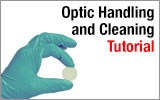
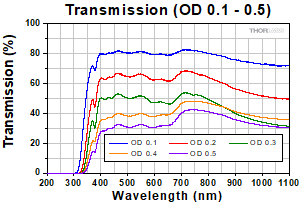
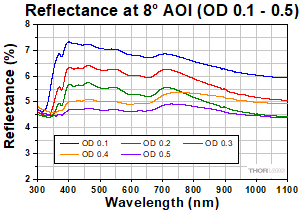
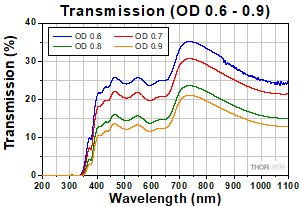
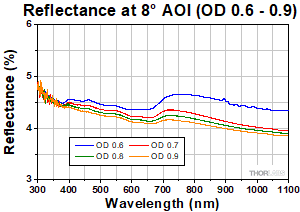
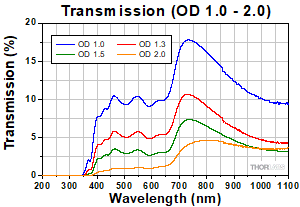
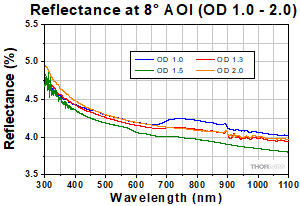
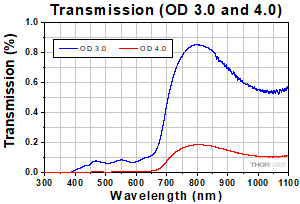
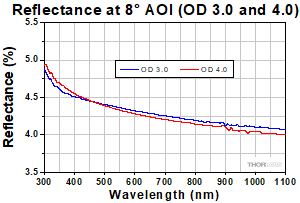
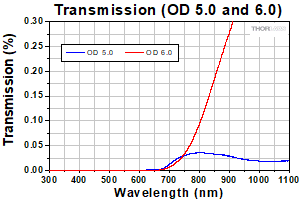
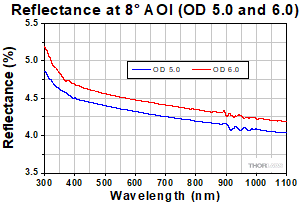
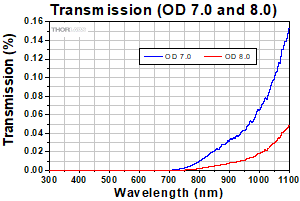
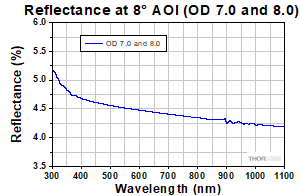

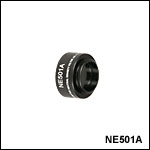
 ズーム
ズーム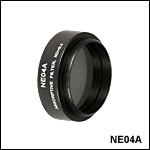
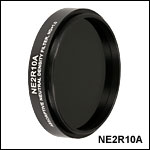
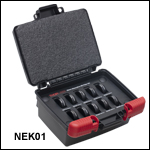
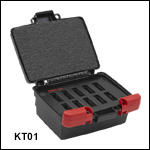
 吸収型NDフィルタ(Schottガラス)マウント付き
吸収型NDフィルタ(Schottガラス)マウント付き